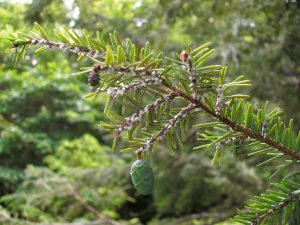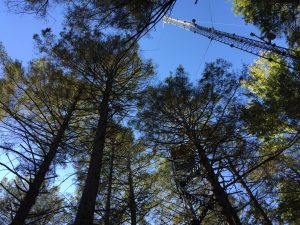5 April 2017
Research links decline in hemlock forests to changes in water resources
Posted by Lauren Lipuma
By Steve Hinnefeld

Branches of eastern hemlock in the Harvard Forest in Massachusetts are covered by fluffy wool once infested by hemlock woolly adelgid, an insect infestation that is killing hemlock trees in New England forests. The woolly adelgid infestation is having a significant impact on the water resources of forested ecosystems that provide essential water supplies to one of the nation’s most populous regions, according to a new study.
Credit: David A. Orwig
An insect infestation that is killing hemlock trees in New England forests is having a significant impact on the water resources of forested ecosystems that provide essential water supplies to one of the nation’s most populous regions, a new study finds.
The study is the first to show an increase in water yield — the amount of water reaching streams and rivers — resulting from forest damage caused by an insect pest called the hemlock woolly adelgid. Insect-damaged trees use less rainfall and allow more to reach the ground and run off into waterways. With less foliage, the trees return less moisture to the atmosphere via transpiration and evaporation.
“We observed a 15 percent increase in annual water yield,” said Taehee Hwang, an assistant professor in the Department of Geography at Indiana University in Bloomington and co-author of the new study. “But there are a lot of issues involved with this subject. Water quality may suffer as rainfall runs off more quickly from forested areas and carries higher concentrations of nutrients. The long-term picture may change as hemlocks are replaced with broad-leaved trees that have a different impact on water resources.”
The new study was published in Geophysical Research Letters, a journal of the American Geophysical Union. The research was conducted at Harvard University’s Harvard Forest in Petersham, Mass., about 75 miles west of Boston. The locale adds significance to the findings.
“Surface water resources are very important across the eastern U.S., and forests are important sources for clean water,” Hwang said. “The study site for this research is in the headwater area for the main water supply reservoir for the greater Boston area.”
Eastern hemlock trees are large, attractive evergreens that are found from Canada to Georgia, often growing in cool regions on slopes and near streams and rivers. In many areas, they are a foundation species, playing a key role in structuring the ecological community.
But hemlock forests in the Eastern U.S. have been devastated by the hemlock woolly adelgid, a tiny insect that feeds on the twigs of hemlock, near the base of the foliage. The adelgid, an invasive species from Japan, has largely wiped out hemlock forests in the Southern Appalachians.

Two eddy-covariance flux towers at the Harvard Forest in New England where the hemlock woolly adelgid infestation has resulted in eastern hemlock mortality.
Credit: David A. Orwig
The pests reached New England by the mid-1980s and two decades later infested the Massachusetts forests where the study was conducted. The northward spread of the infestation has been slowed by cold winter temperatures, which kill many of the adelgid, but the spread is likely to accelerate as a result of climate change, Hwang said.
In the study, the researchers used various measures to understand the impact of the hemlock woolly adelgid on freshwater yields. They charted the flow of water in streams and observed changes in the health of hemlock trees. They also measured the movement of water to the atmosphere via evaporation and transpiration from the hemlock-dominated canopy region and then modeled the net effect of the adelgid infestation using various methods.
They found that evaporation and transpiration decreased between 24 percent and 37 percent in a 10-year period. Comparing a watershed with more hemlock trees to a similar watershed nearby with fewer hemlocks, they found a 15.6 percent increase in annual water yield over approximately the same period.
Hwang said more research is needed to determine if the increase in streamflow is a long-term feature or if it will reverse as hemlock trees die and are replaced by broad-leaved trees. More research is also needed, he said, to evaluate the effect of losing hemlock trees on water quality.
— Steve Hinnefeld is a news and media specialist at Indiana University. This post originally appeared as a press release on the Indiana University website.


 GeoSpace is a blog on Earth and space science, managed by AGU’s Public Information staff. The blog features posts by AGU writers and guest contributors on all sorts of relevant science topics, but with a focus on new research and geo and space sciences-related stories that are currently in the news.
GeoSpace is a blog on Earth and space science, managed by AGU’s Public Information staff. The blog features posts by AGU writers and guest contributors on all sorts of relevant science topics, but with a focus on new research and geo and space sciences-related stories that are currently in the news.